The AMD Radeon R9 290X Review
by Ryan Smith on October 24, 2013 12:01 AM EST- Posted in
- GPUs
- AMD
- Radeon
- Hawaii
- Radeon 200
GRID 2
The final game in our benchmark suite is also our racing entry, Codemasters’ GRID 2. Codemasters continues to set the bar for graphical fidelity in racing games, and with GRID 2 they’ve gone back to racing on the pavement, bringing to life cities and highways alike. Based on their in-house EGO engine, GRID 2 includes a DirectCompute based advanced lighting system in its highest quality settings, which incurs a significant performance penalty but does a good job of emulating more realistic lighting within the game world.
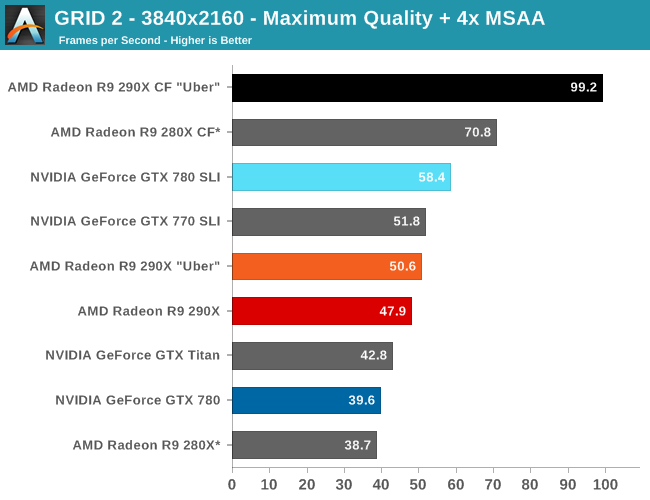
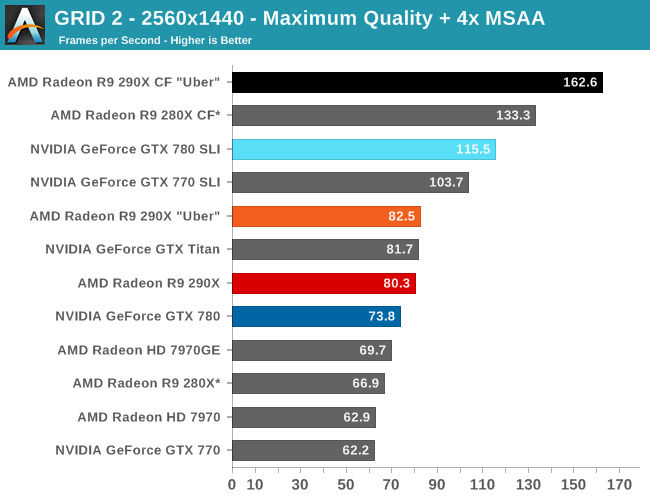
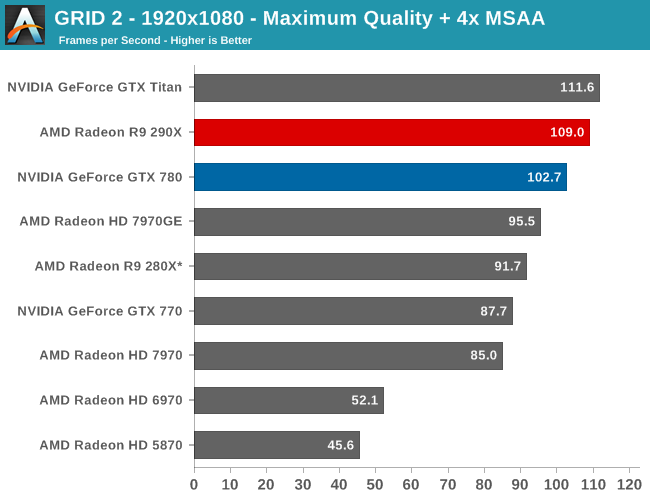
For as good looking as GRID 2 is, it continues to surprise us just how easy it is to run with everything cranked up, even the DirectCompute lighting system and MSAA (Forward Rendering for the win!). At 2560 the 290X has the performance advantage by 9%, but we are getting somewhat academic since it’s 80fps versus 74fps, placing both well above 60fps. Though 120Hz gamers may still find the gap of interest.
Moving up to 4K, we can still keep everything turned up including the MSAA, while pulling off respectable single-GPU framerates and great multi-GPU framerates. To no surprise at this point, the 290X further extends its lead at 4K to 21%, but as usually is the case you really want two GPUs here to get the best framerates. In which case the 290X CF is the runaway winner, achieving a scaling factor of 96% at 4K versus NVIDIA’s 47%, and 97% versus 57% at 2560. This means the GTX 780 SLI is going to fall just short of 60fps once more at 4K, leaving the 290X CF alone at 99fps.
Unfortunately for AMD their drivers coupled with GRID 2 currently blows a gasket when trying to use 4K @ 60Hz, as GRID 2 immediately crashes when trying to load with 4K/Eyefinity enabled. We can still test at 30Hz, but those stellar 4K framerates aren’t going to be usable for gaming until AMD and Codemasters get that bug sorted out.
Finally, it’s interesting to note that for the 290X this is the game where it gains the least on the 280X. The 290X performance advantage here is just 20%, 5% lower than any other game and 10% lower than the average. The framerates at 2560 are high enough that this isn’t quite as important as in other games, but it does show that the 290X isn’t always going to maintain that 30% lead over its predecessor.
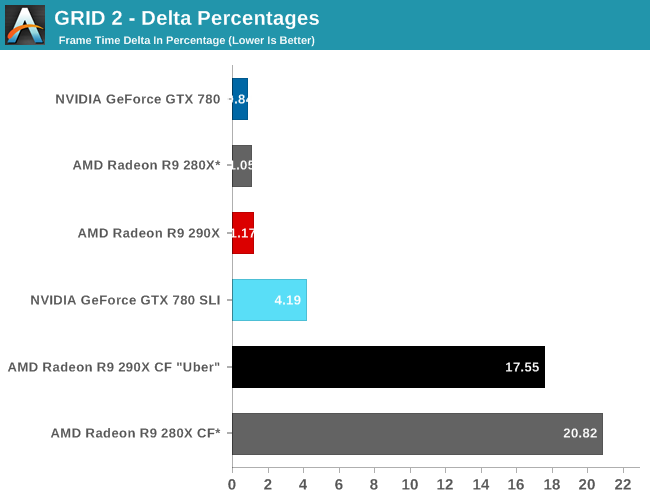
Without any capturable 4K FCAT frametimes, we’re left with the delta percentages at 2560, which more so than any other game are simply not in AMD’s favor. The GTX 780 SLI is extremely consistent here, to the point of being almost absurdly so for a multi-GPU setup. 4% is the kind of variance we expect to find with a single-GPU setup, not something incorporating multiple GPUs. AMD on the other hand, though improving over the 280X by a few percent, is merely adequate at 17%. The low frame times will further reduce the real world impact of the difference between the GTX 780 SLI and 290X CF here, but this is another game AMD could stand some improvements, even if it costs AMD some of the 290X’s very strong CF scaling factor.


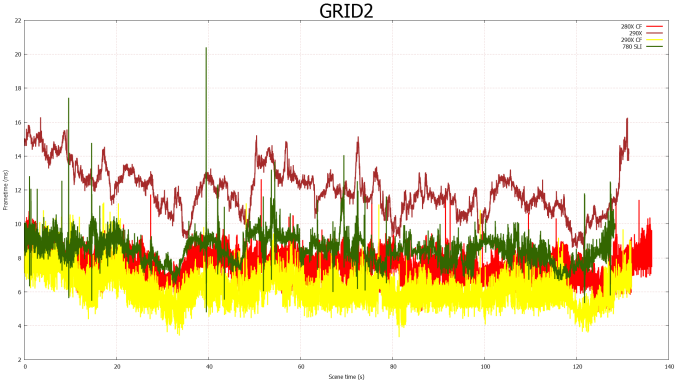








396 Comments
View All Comments
Da W - Thursday, October 24, 2013 - link
The reference cooler is noisy as hell, but it's a blower. At least it doesn't dump all the heat inside your case and let your other case fans handle it. It depends what you're looking for.Still make as much noise as the 5870 did, and it was a commercial success.
slickr - Thursday, October 24, 2013 - link
Didn't think AMD will deliver, in fact I thought from seeing some initial benchmarks that AMD took over 6 months just to deliver a graphic card slower than Titan and that even with a cheap price it wouldn't be enough, boy was I wrong.This card beats Titan in so many games and in so many resolutions and is almost $500 cheaper, its also $100 cheaper than the GTX 780 and anywhere from 5% to 20% faster than the 780, that is just amazing.
Hopefully this trickles down to the medium range cards and we are going to see cards like the 280x go for less than $250.
I mean unless Nvidia positiones the Titan at $550 as well, then I don't think it will sell very much at all. In the 290x you have a better performing card at almost half the price, Nvidia has its work cut out for them and I sure hope the 780 TI edition really brings in the performance and price as well.
eanazag - Thursday, October 24, 2013 - link
I'm sporting a Nvidia GPU in my rig. I don't see any option for Nvidia than to reduce both the Titan, 770, and 780 in cost. I can't expect the 780 Ti performance to trump the Titan. I will say that there is power and cooling room for Nvidia to ratchet things up and make this interesting. This is bold move on AMDs part and does wonders for consumers. Based on some of the other comments current news does not kill off either brand by the way. PC gaming and desktops are not dead.....kwrzesien - Thursday, October 24, 2013 - link
Ryan, can we get a pipeline article or retweet this article when it is complete? Thanks!spiked_mistborn - Thursday, October 24, 2013 - link
Nice job AMD! Competition is good! Also, feel free to use my GSYNC idea about putting a frame buffer in the display and letting the video card control the refresh rate. This post is from March 2013. Apparently adding a dash to make it G-Sync makes it different somehow. http://techreport.com/discussion/24553/inside-the-...Sorodsam - Thursday, October 24, 2013 - link
I'm surprised no one's commented on the new "AMD Center", or this troubling text:"You've landed on the AMD Portal on AnandTech. This section is sponsored by AMD."
There's a big difference between a site that runs an occasional AMD ad and a site with an entire section that's expressively "sponsored by AMD", especially considering AnandTech's (former?) guiding principle that product reviewers shouldn't be aware of who exactly is buying advertising and when. They can hardly be unaware of it now.
MrMaestro - Thursday, October 24, 2013 - link
The reason people aren't commenting on it is because it's already been commented on. Take a look at the article announcing AMD Centre. That is the appropriate place for such comments.anevmann - Thursday, October 24, 2013 - link
Ryan, will this card require PCIe 3.0 for gaming?Can you do a test with and without PCIe 3.0? I really want this card, but I wanna know in advance if I have to upgrade my system.
A
Ryan Smith - Monday, October 28, 2013 - link
I can't promise when it will be done (given the insanity of our schedule over the next 3 weeks), but at some point we will follow this up with a reprise article, that among other things will cover PCIe bandwidth vs. Crossfire scaling, CF testing in quiet mode, and some noise equalization to see what fan levels it would take to match a GTX 780 and what the resulting performance would look like.Anyhow, for a single card setup none of my data thus far supports PCIe 3.0 being a requirement. We're not to the point yet where PCIe 2.0 x16 is a general gaming bottleneck.
Hung_Low - Thursday, October 24, 2013 - link
Is 290X really the absolute maxed out version Tahiti? Or did it also leave a lot of room like Titan is for GK110.Perhaps the GPUs used in 290x are those Tahiti's with imperfection, with the high quality Tahiti's saved for extreme edition 290x/290x+ ?